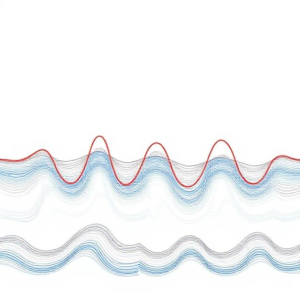1. What is Longitudinal Strain?
In simple terms, longitudinal strain is a measure of how much an object has been stretched or compressed along its length when a force is applied.
- Imagine pulling on a rubber band. When you pull, the rubber band stretches in the direction of the pull — this is an example of longitudinal strain.
- If you compress something (like a spring), it shortens along the direction of the compression. This is also a longitudinal strain.
Mathematically, longitudinal strain is defined as the change in length of an object divided by its original length:
For example, if you stretch a rubber band by 2 cm and its original length was 10 cm, the strain would be:
So, the strain tells you how much an object has been deformed in the direction of the force.

2. What are Longitudinal Waves?
A longitudinal wave is a type of wave where the particles of the medium move back and forth in the same direction as the wave travels. In other words, the motion of the particles is parallel to the direction of the wave.
How Longitudinal Waves Work:
Think of a slinky (a spring toy):
- If you push and pull one end of the slinky, you will create compressions and rarefactions along the length of the slinky.
- Compressions are areas where the coils of the slinky are close together.
- Rarefactions are areas where the coils are spread apart.
In a longitudinal wave, particles move in a way that creates these alternating areas of compression and rarefaction.
3. Examples of Longitudinal Waves:
- Sound Waves:
- When sound travels through air (or any medium), it moves as a longitudinal wave. The air particles vibrate back and forth in the same direction the sound is traveling.
- For example, when you speak, your vocal cords cause air molecules to compress and expand, sending sound waves toward someone.
- Shock Waves:
- When an object moves faster than the speed of sound (like a plane breaking the sound barrier), it creates a shock wave, which is a type of longitudinal wave.
4. Longitudinal Waves vs. Transverse Waves:
- Longitudinal Waves: The particles move parallel to the direction the wave is traveling. Example: Sound waves.
- Transverse Waves: The particles move perpendicular (up and down) to the direction of the wave. Example: Water waves or light waves.
5. Key Characteristics of Longitudinal Waves:
- Direction of Motion: In a longitudinal wave, particles move in the same direction as the wave itself (back and forth along the direction of travel).
- Compressions and Rarefactions: These are the two main features. Compressions are areas of high pressure (particles are close together), and rarefactions are areas of low pressure (particles are spread apart).
- Speed: The speed of a longitudinal wave depends on the properties of the medium (like air, water, or solid objects).
6. Summary of Longitudinal Strain and Waves:
- Longitudinal Strain is how much an object has been stretched or compressed along its length when a force is applied.
- Longitudinal Waves are waves where the particles of the medium move back and forth in the same direction as the wave travels. These waves create compressions and rarefactions in the medium.
Conclusion:
- Longitudinal Strain is a way to measure how much an object stretches or compresses when a force acts along its length.
- Longitudinal Waves are waves in which particles move in the same direction as the wave, such as sound waves or shock waves.
Tags: 0.2 strain, air vibrations, back-and-forth motion, change in length, compression, compressions, deformation, example strain, force applied, high pressure, length change, Light Waves, Longitudinal strain, longitudinal vs transverse waves, Longitudinal Waves, low pressure, measurement of deformation, medium properties, original length, parallel motion, particle motion, perpendicular motion, rarefactions, rubber band, shock waves, slinky, sound barrier, Sound Waves, spring, strain formula, stretch, summary, transverse waves, vocal cords, Water Waves, wave direction, Wave Propagation, wave speed, wave types


